SEO
Building An Integrated Search Strategy

Digital transformation is here.
But is it really here for search marketers?
According to Google,
“Now is the time to reset, pivot, and think big to transform your business operations to match new digital expectations.”
Search marketers need to transform.
Looking at all your audiences and connecting them to relevant search engines – not just Google – truly allows digital marketers to transform.
Every search engine is different; in results, modes of search, and keyword intent (i.e., what keywords we use on each search engine varies).
It is not possible to duplicate what you are doing on Google and think it will work on YouTube and/or Amazon (or any other search engine for that matter).
As you begin your integrated search strategy, looking at one search engine can help you start to think about the others.
Generally speaking, we use:
- Google to find.
- Amazon to buy.
- YouTube to watch.
When it comes to integrated search strategies, let’s begin by identifying what our focus engine/s are.
Identify Your Core Focus Areas Based On Your Audience And Analyze What The Search Engine Displays
Amazon is all about products.
Get to know your product performance. For brands, this isn’t just looking at Brand Analytics via Amazon Seller Central.
Here are the core and secondary focus of the ‘big three’ search engines:
| Search engine | Core focus | Secondary focus |
| Amazon | ||
|
||
| YouTube |
Review your Amazon performance and visibility (i.e., how well you rank) on Google. This will help you start to build out your keyword strategy.
You can do this by looking at which keywords Google ranks Amazon for.
Are any of these URLs your Amazon products? Do any of these keywords have an Amazon “double bubble”?
This might be a stronger indication that that keyword has high commercial intent. So much so that Google ranks Amazon more than once.
Amazon double bubbles are even more important on Google when they occur in higher-ranked positions.
Equally, if you see YouTube ranking, predominantly, on Google (e.g. displaying YouTube timestamps), this may be an indication that these keywords are more video-platform friendly.
Keep an eye on YouTube ranking for a traditional result too. It’s not always about timestamps.
When you see the usual diverse Google layout, one with lots of different search engine results page (SERP) features, this would be an indication that that keyword requires a Google platform focus.
Since we are talking about integrated search, let’s not just look at Google.
Google is a competitor of many search engines, including YouTube. (Even though they are part of the same company, Alphabet.)
According to eMarketer:
“Amazon’s first-party data on consumer shopping and purchase habits offer it an advantage over the more general online behavioral data that Facebook and Google provide.”
This is why Google has created things like Google Shopping and Google Jobs to fend off other large search engines like Amazon, Indeed, or Glassdoor, becoming the most dominant.
Each engine has very unique data, search behavior, and results. Every engine that your audience uses, needs its own strategy.
Overreliance and underinvestment in looking at each search engine’s data will limit your ability to create an integrated search strategy.
On-site search is beneficial.
On-Site Search (OSS)
Since the interface (and the functions of that interface) impact our search behavior, your top internal site search keywords (i.e., what keywords your website users are using within your own search bar) within your website will never fully align with what you see in Google Search Console, for example.
It is, however, a good idea to keep monitoring your internal site searches to continue to evolve your keyword strategy. There are some nuggets in there to help you develop what content you write about.
Internal site search, a form of on-site search (OSS), is powerful because it is based on real user behavior data.
Whenever you can, look at OSS by search engine.
Disclaimer: I work for Similarweb. The company I work for has features using OSS.
Let’s take the product “air conditioner” as an example.
On Google, we search for a wide range of keywords, but most of these are branded keywords, for example, “LG air conditioner” or “Mitsubishi air conditioner”. Overall, these keywords are broad and less specific.
On Amazon, we are more specific and tend to use more non-branded keywords – for example, “portable air conditioner” or “sliding window air conditioner.”
On YouTube, we are interested in both inspirational content at the pre-sale stage (e.g. “best portable air conditioner”), as well as post-sale stage (e.g. “mini split air conditioner installation”).
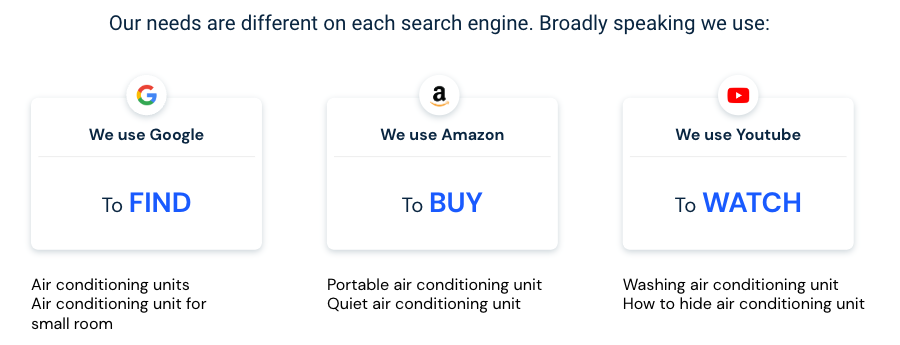 Image from author, January 2023
Image from author, January 2023Any business that ranks on Google and produces videos needs to start creating separate Google and YouTube strategies. Retailers also need to do this for Amazon.
Let’s take a look at how keyword research compares across sites.
Google keyword research:
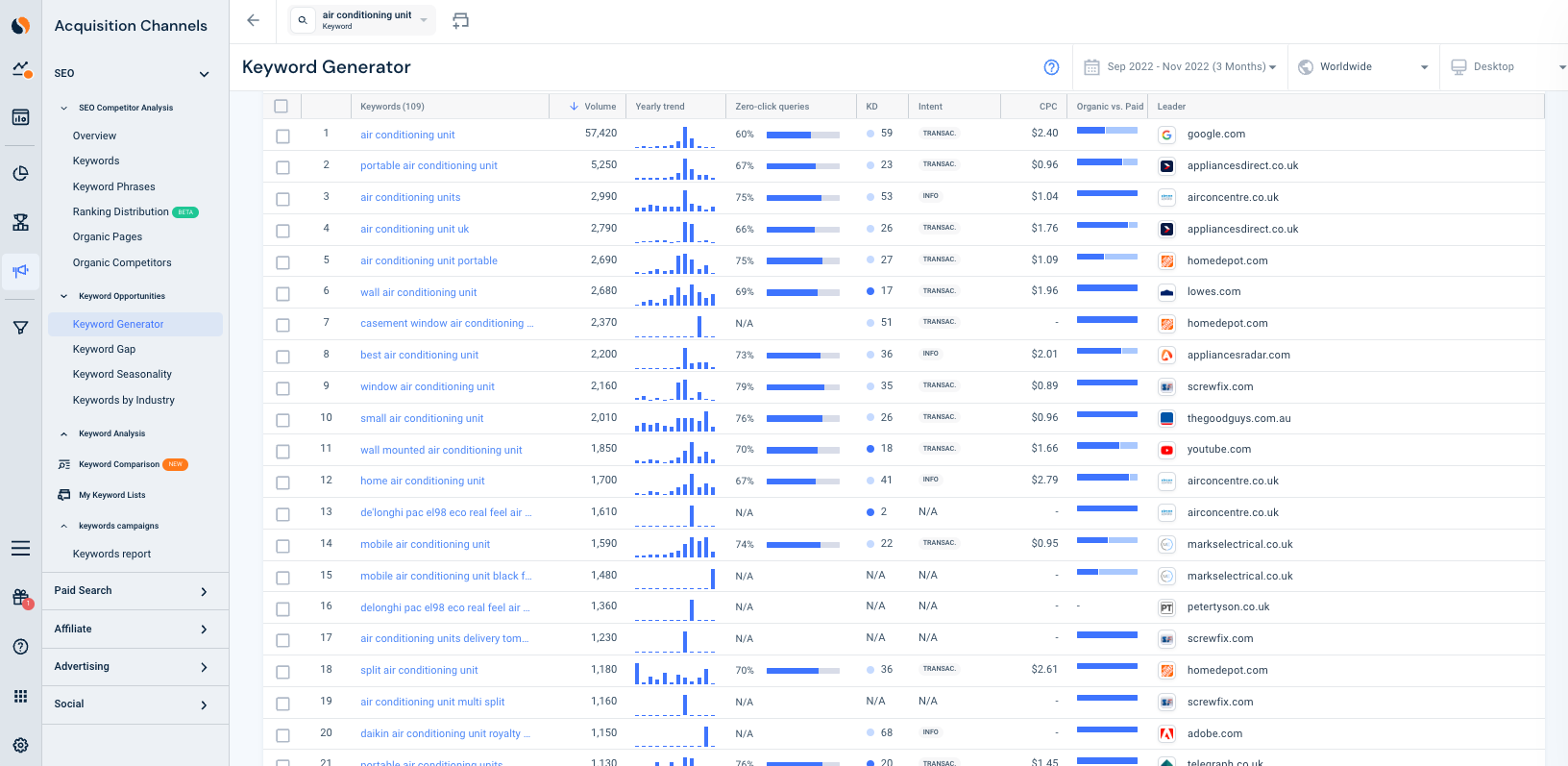 Screenshot by author, January 2023
Screenshot by author, January 2023YouTube keyword research:
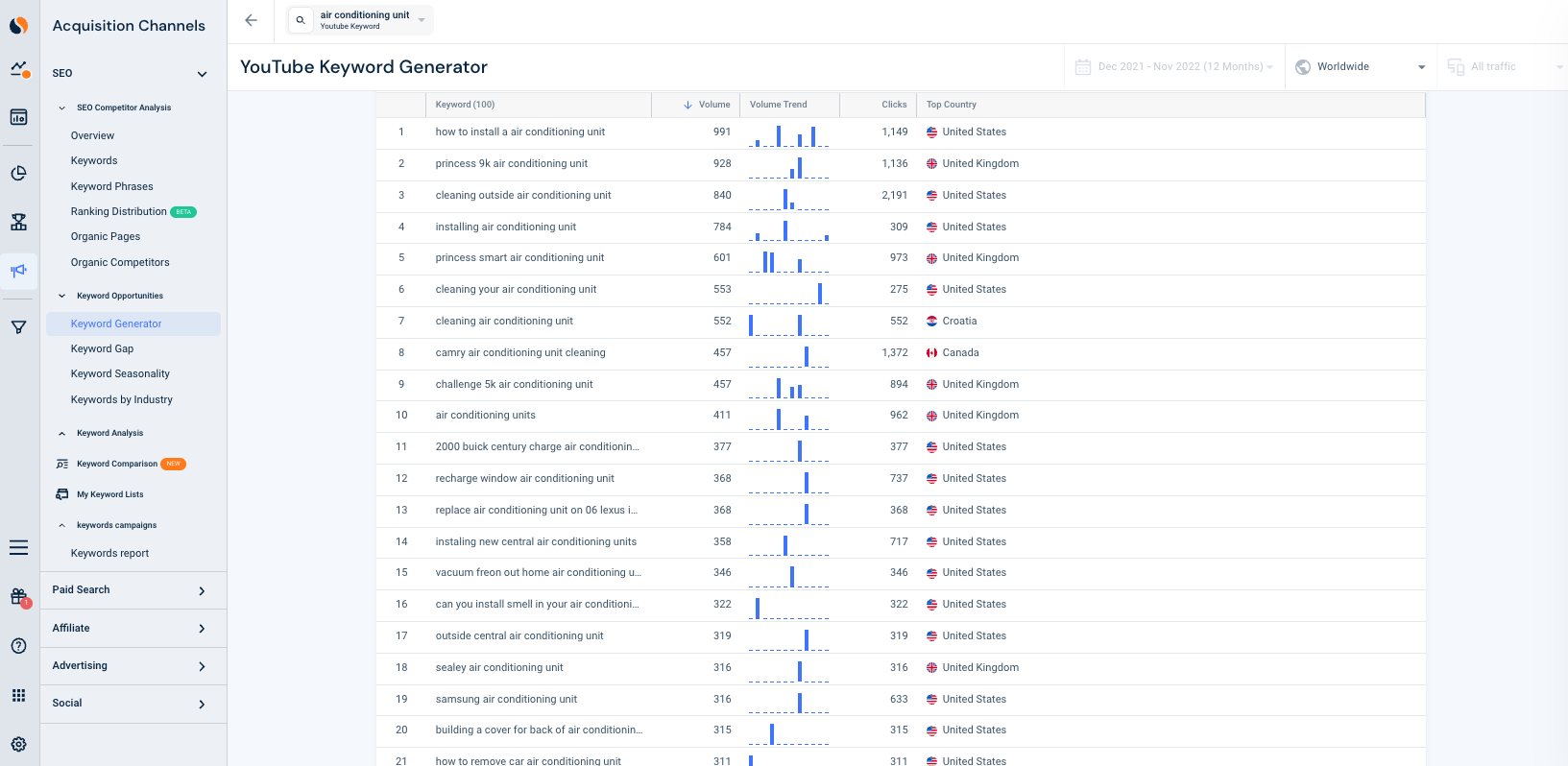 Screenshot by author, January 2023
Screenshot by author, January 2023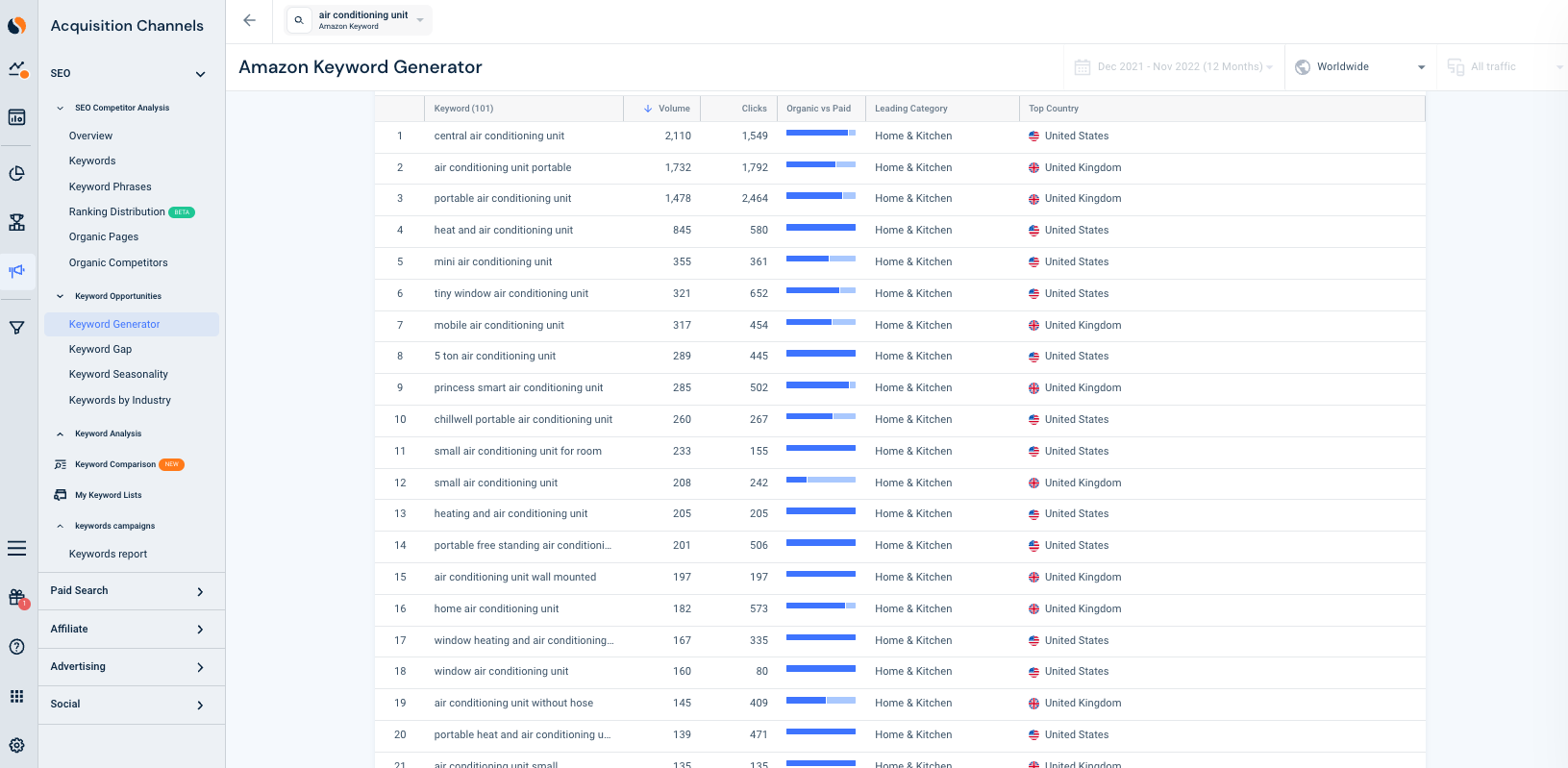 Screenshot by author, January 2023
Screenshot by author, January 2023Buyer’s Journey
Traditionally, and far before digital acceleration was a thing, we used to group keywords by “informational,” “navigational,” and “transactional.”
These categories are outdated for integrated search, as the groupings do not easily align with search engines.
Group your keywords into these stages to get a better alignment with the buyer’s journey and core search engine:
| Buyer’s journey phase | Core search engine | Secondary search engine | Keyword example |
| Awareness | Amazon and YouTube | “Paper” | |
| Consideration | Amazon, Google, and YouTube | “Printer paper” | |
| Decision | Amazon | “A4 printer paper” | |
| Inspiration | YouTube | Amazon and YouTube | “How to make a paper airplane” |
Awareness
- Core search engine: Google (sometimes Amazon and YouTube).
- Keyword example: “Paper”.
Consideration
- Core search engines: Amazon, Google, and YouTube.
- Keyword example: “Printer paper”.
Decision
- Core search engine: Amazon (sometimes Google).
- Keyword example: “A4 printer paper”.
Inspiration
- Core search engine: YouTube (sometimes Amazon and YouTube).
- Keyword example: “How to make an airplane out of printer paper”.
Benefits Of The Buyer’s Journey
Easier alignment to search engines and better performance insights.
Let’s take Google SERP features, for example. Are there more Instant Answers for awareness keywords compared to decision keywords?
SERP features help develop your Google strategy and digital assets on Google. Keywords with videos SERPs should not direct your YouTube strategy.
The buyer’s journey helps you to start building an integrated search strategy across the big three search engines of Amazon, Google, and YouTube.
If you have low SEO resources restricting you from focusing on this, try to set aside 30 minutes a week so you can slowly start to categorize keywords for your most important business unit.
Over the following weeks, you will start to gain valuable insights into an important line of business.
This will help you automatically get attention from other stakeholders internally, which will help you make a business case to do more SEO activities.
This is SEO evangelism at its best: engaging internal stakeholders.
The buyer’s journey is much easier to understand for non-digital audiences compared to a specific search engine’s ranking factors.
E-A-T Content Is Required For Every Search Engine Strategy, But Some Less Than Others
If you need a rundown (or refresher) on E-A-T, the SEJ guide explains it beautifully. Read it here: What Exactly Is E-A-T & Why Does It Matter to Google?
Now, let’s look at E-A-T (expertise, authority, and trustworthiness) from an integrated search perspective.
Google places more emphasis on E-A-T compared to Amazon and YouTube.
Amazon uses E-A-T the least, as it’s still playing catchup on improving its content-specific algorithms.
But since content exists on all three search engines, and to follow best practices, we need to think about E-A-T for all three search engines.
Do not use generic product descriptions on Amazon. If you are reselling, do not copy content from external sources, including from the supplier if you are reselling.
Be reactive on Amazon to user-generated content, in particular to reviews and questions/answers you receive.
Unlike Google and YouTube, you can’t send a piece of consumed text or video back. So keep an eye on order defect rates, stock levels, price, and conversion trends.
On Amazon and Google, keep an eye on reviews; authentic, specialist reviews are important.
As mentioned earlier, Google is the most advanced algorithmically when it comes to E-A-T. But really, E-A-T principles are like university essays.
Key questions to ask:
- Is the content unique? If so, to what extent vs. what else we have seen (in the case of search engines indexed)?
- Who else published about the topic? What are their strengths and weaknesses? How does this domain compare in relation to this?
- What research has been conducted? Are there any references and to which resources/author profiles?
- What questions were addressed? What are missing questions/angles?
- What methods and formats were used?
- What were the key points?
YouTube, like Amazon, factors more real-life metrics into its algorithm. In the case of Amazon, it’s defect rates and stock levels. On YouTube, it’s views, likes, gaining authentic subscribers, and comments.
Shareability is important to all three search engines but more important to Google and YouTube.
Google, for the most part, uses backlinks to monitor shareability.
YouTube may also use backlinks but video shares are more important. Make sure you enable video sharing under options/settings. Engagement is key for YouTube.
How Can I Build An Integrated Search Strategy?
Identify who your audience is, and what their core focus is.
If it’s to target younger audiences who consume video, your keyword strategy needs to be different than just targeting video consumers.
If your company is currently only doing SEO, review Amazon and YouTube performance on Google. This is the easiest way to start getting teams to think and get them to understand that each engine is different.
Understanding Amazon performance on Google at a keyword level, can add another dimension to keyword intent.
Categorize your keywords into the four stages of the buyer’s journey: awareness, consideration, decision, and inspiration. This will help you align your keywords by search engine, too.
Keyword grouping of the buyer’s journey will also add another interesting layer to your understanding of SERP features.
E-A-T your content on every search engine you operate in. Some engines have less emphasis, but remember every engine is getting more sophisticated, some at a slower rate than others.
Stay ahead of the game.
More resources:
Featured Image: Costello77/Shutterstock
SEO
Google On Hyphens In Domain Names
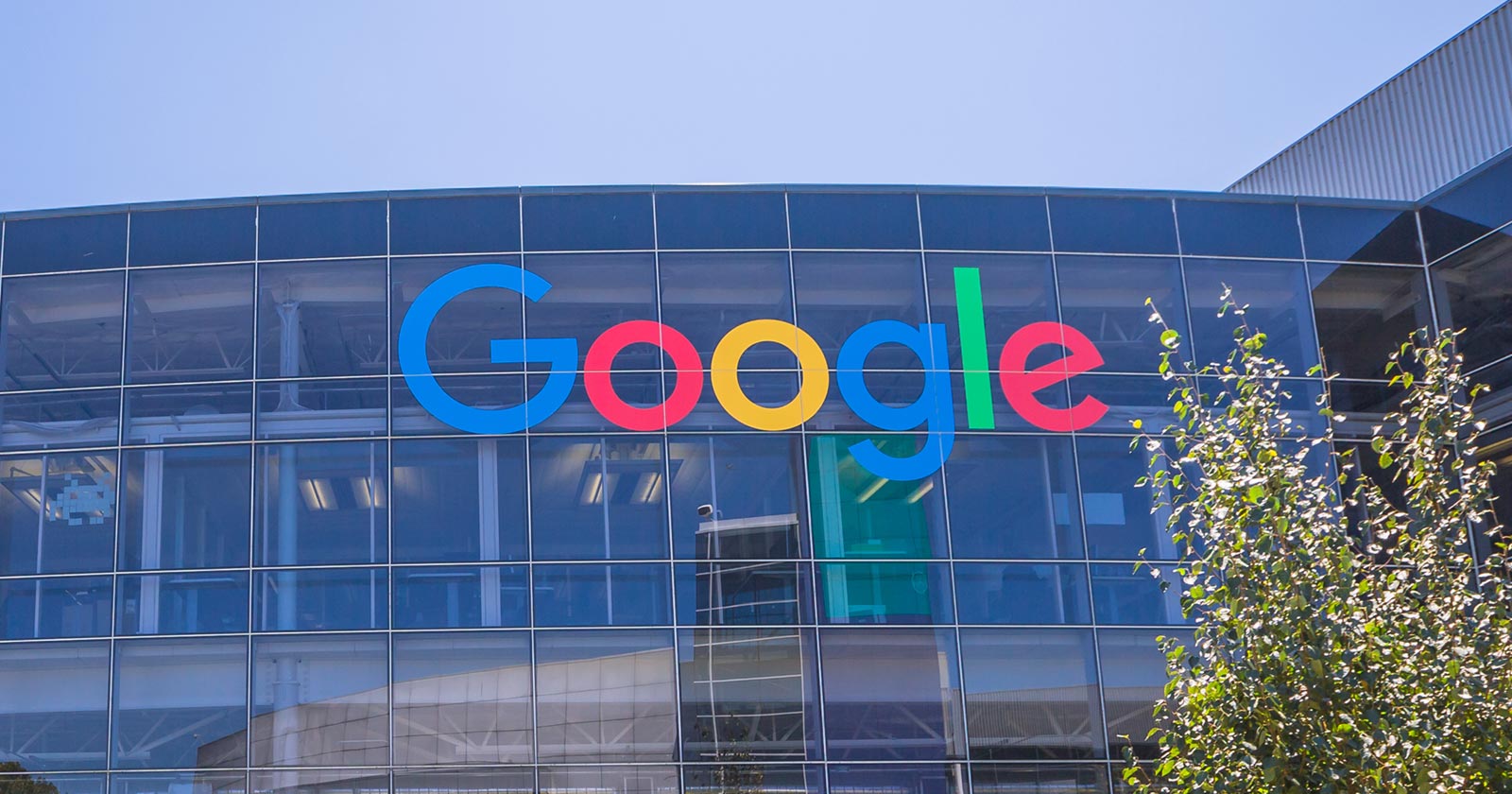
Google’s John Mueller answered a question on Reddit about why people don’t use hyphens with domains and if there was something to be concerned about that they were missing.
Domain Names With Hyphens For SEO
I’ve been working online for 25 years and I remember when using hyphens in domains was something that affiliates did for SEO when Google was still influenced by keywords in the domain, URL, and basically keywords anywhere on the webpage. It wasn’t something that everyone did, it was mainly something that was popular with some affiliate marketers.
Another reason for choosing domain names with keywords in them was that site visitors tended to convert at a higher rate because the keywords essentially prequalified the site visitor. I know from experience how useful two-keyword domains (and one word domain names) are for conversions, as long as they didn’t have hyphens in them.
A consideration that caused hyphenated domain names to fall out of favor is that they have an untrustworthy appearance and that can work against conversion rates because trustworthiness is an important factor for conversions.
Lastly, hyphenated domain names look tacky. Why go with tacky when a brandable domain is easier for building trust and conversions?
Domain Name Question Asked On Reddit
This is the question asked on Reddit:
“Why don’t people use a lot of domains with hyphens? Is there something concerning about it? I understand when you tell it out loud people make miss hyphen in search.”
And this is Mueller’s response:
“It used to be that domain names with a lot of hyphens were considered (by users? or by SEOs assuming users would? it’s been a while) to be less serious – since they could imply that you weren’t able to get the domain name with fewer hyphens. Nowadays there are a lot of top-level-domains so it’s less of a thing.
My main recommendation is to pick something for the long run (assuming that’s what you’re aiming for), and not to be overly keyword focused (because life is too short to box yourself into a corner – make good things, course-correct over time, don’t let a domain-name limit what you do online). The web is full of awkward, keyword-focused short-lived low-effort takes made for SEO — make something truly awesome that people will ask for by name. If that takes a hyphen in the name – go for it.”
Pick A Domain Name That Can Grow
Mueller is right about picking a domain name that won’t lock your site into one topic. When a site grows in popularity the natural growth path is to expand the range of topics the site coves. But that’s hard to do when the domain is locked into one rigid keyword phrase. That’s one of the downsides of picking a “Best + keyword + reviews” domain, too. Those domains can’t grow bigger and look tacky, too.
That’s why I’ve always recommended brandable domains that are memorable and encourage trust in some way.
Read the post on Reddit:
Read Mueller’s response here.
Featured Image by Shutterstock/Benny Marty
SEO
Reddit Post Ranks On Google In 5 Minutes

Google’s Danny Sullivan disputed the assertions made in a Reddit discussion that Google is showing a preference for Reddit in the search results. But a Redditor’s example proves that it’s possible for a Reddit post to rank in the top ten of the search results within minutes and to actually improve rankings to position #2 a week later.
Discussion About Google Showing Preference To Reddit
A Redditor (gronetwork) complained that Google is sending so many visitors to Reddit that the server is struggling with the load and shared an example that proved that it can only take minutes for a Reddit post to rank in the top ten.
That post was part of a 79 post Reddit thread where many in the r/SEO subreddit were complaining about Google allegedly giving too much preference to Reddit over legit sites.
The person who did the test (gronetwork) wrote:
“…The website is already cracking (server down, double posts, comments not showing) because there are too many visitors.
…It only takes few minutes (you can test it) for a post on Reddit to appear in the top ten results of Google with keywords related to the post’s title… (while I have to wait months for an article on my site to be referenced). Do the math, the whole world is going to spam here. The loop is completed.”
Reddit Post Ranked Within Minutes
Another Redditor asked if they had tested if it takes “a few minutes” to rank in the top ten and gronetwork answered that they had tested it with a post titled, Google SGE Review.
gronetwork posted:
“Yes, I have created for example a post named “Google SGE Review” previously. After less than 5 minutes it was ranked 8th for Google SGE Review (no quotes). Just after Washingtonpost.com, 6 authoritative SEO websites and Google.com’s overview page for SGE (Search Generative Experience). It is ranked third for SGE Review.”
It’s true, not only does that specific post (Google SGE Review) rank in the top 10, the post started out in position 8 and it actually improved ranking, currently listed beneath the number one result for the search query “SGE Review”.
Screenshot Of Reddit Post That Ranked Within Minutes
Anecdotes Versus Anecdotes
Okay, the above is just one anecdote. But it’s a heck of an anecdote because it proves that it’s possible for a Reddit post to rank within minutes and get stuck in the top of the search results over other possibly more authoritative websites.
hankschrader79 shared that Reddit posts outrank Toyota Tacoma forums for a phrase related to mods for that truck.
Google’s Danny Sullivan responded to that post and the entire discussion to dispute that Reddit is not always prioritized over other forums.
Danny wrote:
“Reddit is not always prioritized over other forums. [super vhs to mac adapter] I did this week, it goes Apple Support Community, MacRumors Forum and further down, there’s Reddit. I also did [kumo cloud not working setup 5ghz] recently (it’s a nightmare) and it was the Netgear community, the SmartThings Community, GreenBuildingAdvisor before Reddit. Related to that was [disable 5g airport] which has Apple Support Community above Reddit. [how to open an 8 track tape] — really, it was the YouTube videos that helped me most, but it’s the Tapeheads community that comes before Reddit.
In your example for [toyota tacoma], I don’t even get Reddit in the top results. I get Toyota, Car & Driver, Wikipedia, Toyota again, three YouTube videos from different creators (not Toyota), Edmunds, a Top Stories unit. No Reddit, which doesn’t really support the notion of always wanting to drive traffic just to Reddit.
If I guess at the more specific query you might have done, maybe [overland mods for toyota tacoma], I get a YouTube video first, then Reddit, then Tacoma World at third — not near the bottom. So yes, Reddit is higher for that query — but it’s not first. It’s also not always first. And sometimes, it’s not even showing at all.”
hankschrader79 conceded that they were generalizing when they wrote that Google always prioritized Reddit. But they also insisted that that didn’t diminish what they said is a fact that Google’s “prioritization” forum content has benefitted Reddit more than actual forums.
Why Is The Reddit Post Ranked So High?
It’s possible that Google “tested” that Reddit post in position 8 within minutes and that user interaction signals indicated to Google’s algorithms that users prefer to see that Reddit post. If that’s the case then it’s not a matter of Google showing preference to Reddit post but rather it’s users that are showing the preference and the algorithm is responding to those preferences.
Nevertheless, an argument can be made that user preferences for Reddit can be a manifestation of Familiarity Bias. Familiarity Bias is when people show a preference for things that are familiar to them. If a person is familiar with a brand because of all the advertising they were exposed to then they may show a bias for the brand products over unfamiliar brands.
Users who are familiar with Reddit may choose Reddit because they don’t know the other sites in the search results or because they have a bias that Google ranks spammy and optimized websites and feel safer reading Reddit.
Google may be picking up on those user interaction signals that indicate a preference and satisfaction with the Reddit results but those results may simply be biases and not an indication that Reddit is trustworthy and authoritative.
Is Reddit Benefiting From A Self-Reinforcing Feedback Loop?
It may very well be that Google’s decision to prioritize user generated content may have started a self-reinforcing pattern that draws users in to Reddit through the search results and because the answers seem plausible those users start to prefer Reddit results. When they’re exposed to more Reddit posts their familiarity bias kicks in and they start to show a preference for Reddit. So what could be happening is that the users and Google’s algorithm are creating a self-reinforcing feedback loop.
Is it possible that Google’s decision to show more user generated content has kicked off a cycle where more users are exposed to Reddit which then feeds back into Google’s algorithm which in turn increases Reddit visibility, regardless of lack of expertise and authoritativeness?
Featured Image by Shutterstock/Kues
SEO
WordPress Releases A Performance Plugin For “Near-Instant Load Times”

WordPress released an official plugin that adds support for a cutting edge technology called speculative loading that can help boost site performance and improve the user experience for site visitors.
Speculative Loading
Rendering means constructing the entire webpage so that it instantly displays (rendering). When your browser downloads the HTML, images, and other resources and puts it together into a webpage, that’s rendering. Prerendering is putting that webpage together (rendering it) in the background.
What this plugin does is to enable the browser to prerender the entire webpage that a user might navigate to next. The plugin does that by anticipating which webpage the user might navigate to based on where they are hovering.
Chrome lists a preference for only prerendering when there is an at least 80% probability of a user navigating to another webpage. The official Chrome support page for prerendering explains:
“Pages should only be prerendered when there is a high probability the page will be loaded by the user. This is why the Chrome address bar prerendering options only happen when there is such a high probability (greater than 80% of the time).
There is also a caveat in that same developer page that prerendering may not happen based on user settings, memory usage and other scenarios (more details below about how analytics handles prerendering).
The Speculative Loading API solves a problem that previous solutions could not because in the past they were simply prefetching resources like JavaScript and CSS but not actually prerendering the entire webpage.
The official WordPress announcement explains it like this:
Introducing the Speculation Rules API
The Speculation Rules API is a new web API that solves the above problems. It allows defining rules to dynamically prefetch and/or prerender URLs of certain structure based on user interaction, in JSON syntax—or in other words, speculatively preload those URLs before the navigation. This API can be used, for example, to prerender any links on a page whenever the user hovers over them.”
The official WordPress page about this new functionality describes it:
“The Speculation Rules API is a new web API… It allows defining rules to dynamically prefetch and/or prerender URLs of certain structure based on user interaction, in JSON syntax—or in other words, speculatively preload those URLs before the navigation.
This API can be used, for example, to prerender any links on a page whenever the user hovers over them. Also, with the Speculation Rules API, “prerender” actually means to prerender the entire page, including running JavaScript. This can lead to near-instant load times once the user clicks on the link as the page would have most likely already been loaded in its entirety. However that is only one of the possible configurations.”
The new WordPress plugin adds support for the Speculation Rules API. The Mozilla developer pages, a great resource for HTML technical understanding describes it like this:
“The Speculation Rules API is designed to improve performance for future navigations. It targets document URLs rather than specific resource files, and so makes sense for multi-page applications (MPAs) rather than single-page applications (SPAs).
The Speculation Rules API provides an alternative to the widely-available <link rel=”prefetch”> feature and is designed to supersede the Chrome-only deprecated <link rel=”prerender”> feature. It provides many improvements over these technologies, along with a more expressive, configurable syntax for specifying which documents should be prefetched or prerendered.”
See also: Are Websites Getting Faster? New Data Reveals Mixed Results
Performance Lab Plugin
The new plugin was developed by the official WordPress performance team which occasionally rolls out new plugins for users to test ahead of possible inclusion into the actual WordPress core. So it’s a good opportunity to be first to try out new performance technologies.
The new WordPress plugin is by default set to prerender “WordPress frontend URLs” which are pages, posts, and archive pages. How it works can be fine-tuned under the settings:
Settings > Reading > Speculative Loading
Browser Compatibility
The Speculative API is supported by Chrome 108 however the specific rules used by the new plugin require Chrome 121 or higher. Chrome 121 was released in early 2024.
Browsers that do not support will simply ignore the plugin and will have no effect on the user experience.
Check out the new Speculative Loading WordPress plugin developed by the official core WordPress performance team.
How Analytics Handles Prerendering
A WordPress developer commented with a question asking how Analytics would handle prerendering and someone else answered that it’s up to the Analytics provider to detect a prerender and not count it as a page load or site visit.
Fortunately both Google Analytics and Google Publisher Tags (GPT) both are able to handle prerenders. The Chrome developers support page has a note about how analytics handles prerendering:
“Google Analytics handles prerender by delaying until activation by default as of September 2023, and Google Publisher Tag (GPT) made a similar change to delay triggering advertisements until activation as of November 2023.”
Possible Conflict With Ad Blocker Extensions
There are a couple things to be aware of about this plugin, aside from the fact that it’s an experimental feature that requires Chrome 121 or higher.
A comment by a WordPress plugin developer that this feature may not work with browsers that are using the uBlock Origin ad blocking browser extension.
Download the plugin:
Speculative Loading Plugin by the WordPress Performance Team
Read the announcement at WordPress
Speculative Loading in WordPress
See also: WordPress, Wix & Squarespace Show Best CWV Rate Of Improvement
-

 PPC6 days ago
PPC6 days agoCompetitor Monitoring: 7 ways to keep watch on the competition
-

 PPC6 days ago
PPC6 days agoA History of Google AdWords and Google Ads: Revolutionizing Digital Advertising & Marketing Since 2000
-

 SEARCHENGINES7 days ago
SEARCHENGINES7 days agoMore Google March 2024 Core Update Ranking Volatility
-

 WORDPRESS5 days ago
WORDPRESS5 days agoTurkish startup ikas attracts $20M for its e-commerce platform designed for small businesses
-

 PPC6 days ago
PPC6 days ago31 Ready-to-Go Mother’s Day Messages for Social Media, Email, & More
-

 WORDPRESS7 days ago
WORDPRESS7 days agoThrive Architect vs Divi vs Elementor
-

 MARKETING5 days ago
MARKETING5 days agoRoundel Media Studio: What to Expect From Target’s New Self-Service Platform
-

 SEARCHENGINES5 days ago
SEARCHENGINES5 days agoGoogle Search Results Can Be Harmful & Dangerous In Some Cases













You must be logged in to post a comment Login